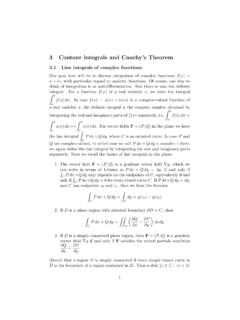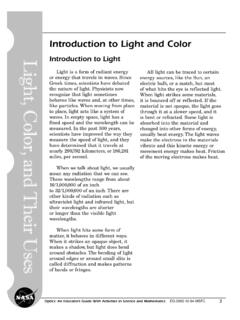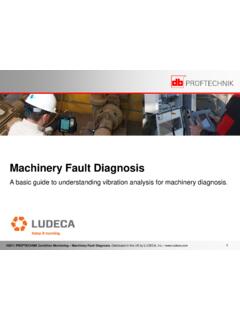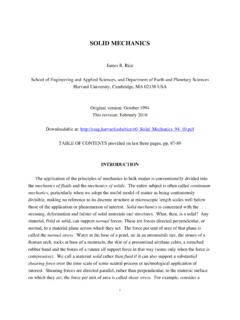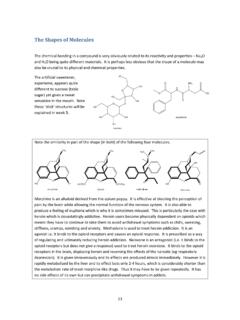Transcription of Euler’s Formula and Trigonometry - Columbia University
1 euler s Formula and TrigonometryPeter WoitDepartment of Mathematics, Columbia UniversitySeptember 10, 2019 These are some notes first prepared for my Fall 2015 Calculus II class, togive a quick explanation of how to think about Trigonometry using euler s for-mula. This is then applied to calculate certain integrals involving The sine and cosine as coordinates of the unitcircleThe subject of Trigonometry is often motivated by facts about triangles, but itis best understood in terms of another geometrical construction, the unit can defineDefinition(Cosine and sine).
2 Given a point on the unit circle, at a counter-clockwise angle from the positivex- axis , cos is thex-coordinate of the point. sin is they-coordinate of the picture of the unit circle and these coordinates looks like this:1 Some trigonometric identities follow immediately from this definition, inparticular, since the unit circle is all the points in plane withxandycoordinatessatisfyingx2+y2= 1, we havecos2 + sin2 = 1 Other trignometric identities reflect a much less obvious property of thecosine and sine functions, their behavior under addition of angles.
3 This is givenby the following two formulas, which are not at all obviouscos( 1+ 2) = cos 1cos 2 sin 1sin 2sin( 1+ 2) = sin 1cos 2+ cos 1sin 2(1)One goal of these notes is to explain a method of calculation which makesthese identities obvious and easily understood, by relating them to propertiesof The complex planeA complex numbercis given as a sumc=a+ibwherea,bare real numbers,ais called the real part ofc,bis called the imaginary part ofc, andiis a symbol with the property thati2= 1. Forany complex numberc, one defines its conjugate by changing the sign of theimaginary partc=a ibThe length-squared of a complex number is given bycc= (a+ib)(a ib) =a2+b22which is a real of the basic tricks for manipulating complex numbers are the following.
4 To extract the real and imaginary parts of a given complex number onecan computeRe(c) =12(c+c)Im(c) =12i(c c)(2) To divide by a complex numberc, one can instead multiply bycccin which form the only division is by a real number, the length-squared of parametrizing points on the plane by pairs (x,y) of real numbers,one can use a single complex numberz=x+iyin which case one often refers to the plane parametrized in this way as the com-plex plane . Points on the unit circle are now given by the complex numberscos +isin These go around the circle once starting at = 0 and ending up back at thesame point when = 2.
5 Now the picture is3A remarkable property of complex numbers is that, since multiplying twoof them gives a third, they provide something new and not at all obvious: aconsistent way of multiplying points on the plane. We will see in the nextsection that multiplication by a point on the unit circle of angle will have aninteresting geometric interpretation, as counter-clockwise rotation by an angle .3 euler s formulaThe central mathematical fact that we are interested in here is generally called euler s Formula , and writtenei = cos +isin Using equations 2 the real and imaginary parts of this Formula arecos =12(ei +e i )sin =12i(ei e i )(which, if you are familiar with hyperbolic functions, explains the name of thehyperbolic cosine and sine).
6 In the next section we will see that this is a very useful identity (and those ofa practical bent may want to skip ahead to this), but first we should address thequestion of what exactly the left-hand side means. The notation used impliesthat it is the numbereraised to the poweri and a striking example of thisis the special case of = , which saysei = 1which relates three fundamental constants of mathematics (e,i, ) althoughthese seem to have nothing to do with each other. The problem though isthat the idea of multiplying something by itself an imaginary number of timesdoes not seem to make any understand the meaning of the left-hand side of euler s Formula , it is bestto recall that for real numbersx, one can instead writeex= exp(x)and think of this as a function ofx, the exponential function, with name exp.
7 The true signficance of euler s Formula is as a claim that the definition of theexponential function can be extended from the real to the complex numbers,preserving the usual properties of the exponential. For any complex numberc=a+ibone can apply the exponential function to getexp(a+ib) = exp(a) exp(ib) = exp(a)(cosb+isinb)4 The trigonmetric addition formulas (equation 1) are equivalent to the usualproperty of the exponential, now extended to any complex numbersc1=a1+ib1andc2=a2+ib2, givingec1+c2=ea1+a2ei(b1+b2)=ea1+a2(cos( b1+b2) +isin(b1+b2))=ea1+a2((cosb1cosb2 sinb1sinb2) +i(sinb1cosb2+ cosb1sinb2))=ea1(cosb1+isinb1)ea2(cosb2+ isinb2)
8 =ec1ec2It is possible to show thatei = cos +isin has the correct exponentialproperty purely geometrically, without invoking the trigonometric addition for-mulas. One can do this by showing that multiplication of a pointz=x+iyin the complex plane byei rotates the point about the origin by a counter-clockwise angle . It then follows that multiplication by the product ofei 1andei 2will be counterclockwise rotation by an angle 1+ 2, implying the correctexponential propertyei 1ei 2=ei( 1+ 2)To show that multiplication byei will give a rotation by , one can argueas follows.
9 One can easily see that multiplication byei rotates the pointz= 1along the unit circle by an angle , taking (in terms of real coordinates)(1,0) (cos ,sin )This is also true for the pointz=i, which gets taken toi(cos +isin ) = sin +icos . In terms of real coordinates on the plane, this is(0,1) ( sin ,cos )and the rotation looks like this:5An arbitrary point on the plane is a linear combination of the points (1,0)and (0,1), and one can see that multiplication byei will act as rotation by on any such linear combination, knowing that it does so for the cases of (1,0)and (0,1).
10 Two other ways to motivate an extension of the exponential function tocomplex numbers, and to show that euler s Formula will be satisfied for such anextension are given in the next two as a solution of a differential equationThe exponential functionsf(x) = exp(cx) forca real number has the propertyddxf=cfOne can ask what function ofxsatisfies this equation forc=i. Using thederivatives of the cosine and sine one findsddx(cosx+isinx) = sinx+icosx=i(cosx+isinx)so cosx+isinxhas the correct derivative to be the desired extension of theexponential function to the casec= and power series expansionsBy the end of this course, we will see that the exponential function can berepresented as a power series , a polynomial with an infinite number ofterms, given byexp(x) = 1 +x+x22!







